Motorola Solutions 99FT7005 Limited Modular Approval User Manual 09L69 O
Motorola Solutions, Inc. Limited Modular Approval 09L69 O
Exhibit D Users Manual per 2 1033 b3
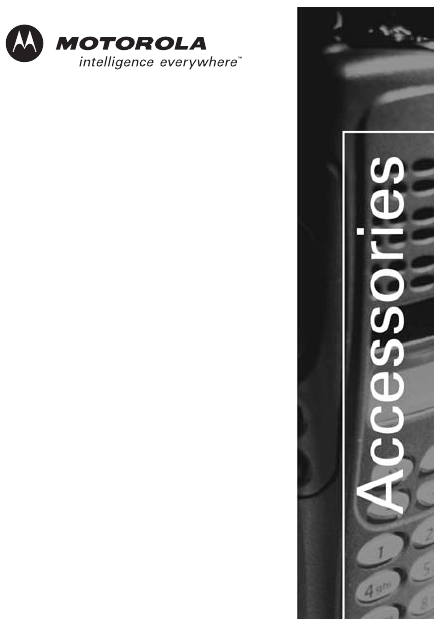
RLN5381 Option Board
with Bluetooth™ Wireless Technology
for the Professional Portable Radio Series
6880309L69-O
TABLE OF CONTENTS
Safety and General Information ........................................ 1
Guidelines on Interference and Lost Links ...................... 1
Regulatory ....................................................................... 2
Range..............................................................................2
Electromagnetic Interference/Compatibility ....................3
2.4 GHz Equipment Compatibility ...................................3
Facilities ..........................................................................3
Aircraft ............................................................................. 3
Medical Devices ..............................................................3
Installation and Programming ...........................................5
Bluetooth Radio Overview.................................................6
Connecting for the First Time .......................................... 7
Verifying Connection ....................................................... 8
Receiving a Call .............................................................. 8
Sending a Call ................................................................. 9
Resolving a Lost Link ......................................................9
Channel Change ...........................................................10
Ending a Connection ..................................................... 10
Connecting to Last Device(s) ........................................10
Connecting to Different Device(s) .................................11
Turning Radio Off ..........................................................12
Tone Description ...........................................................13
Troubleshooting.............................................................13
Service ..........................................................................13
Warranty........................................................................13
Replacement Parts........................................................ 14
1
SAFETY AND GENERAL INFORMATION
IMPORTANT INFORMATION ON SAFE AND
EFFICIENT OPERATION.
READ THIS INFORMATION BEFORE USING YOUR
MOTOROLA OPTION BOARD WITH BLUETOOTH
WIRELESS TECHNOLOGY.
Guidelines on Interference and Lost Links
This device operates in the unlicensed ISM frequency
band (2.402-2.480 GHz). Devices operating in an
unlicensed frequency band are subject to interference
from other devices. Interference effects range in severity
from poor or garbled audio to a complete loss of
communication between a Motorola two-way radio with
Bluetooth wireless technology and a corresponding
Motorola accessory with Bluetooth wireless technology.
The latter effect is referred to as a “lost link” and results
in the inability to use the accessory with Bluetooth
wireless technology.
ALWAYS KEEP YOUR TWO-WAY RADIO READILY
AVAILABLE FOR USE IN THE EVENT THE
BLUETOOTH WIRELESS LINK IS LOST.
Examples of potential interference sources operating in
the ISM band include 802.11b wireless local area
networks (LANs), Home RF residential wireless LANs,
microwave ovens, computers, and 2.4 GHz wireless
phones.
2
Regulatory
Users are not permitted to make changes or modify the
device in any way. Changes or modifications not
expressly approved by the party responsible for
compliance could void the user’s authority to operate
the device. See 47 CFR Sec. 15.21.
This device complies with Part 15 of the U.S. FCC
Rules. Operation is subject to the following two
conditions:
(1) This device may not cause harmful interference, and
(2) this device must accept any interference received,
including interference that may cause undesired
operation. See 47 CFR Sec. 15.19(3).
This device operates in the 2.402 - 2.480 GHz
frequency range. Some countries have restrictions
against using devices in this range. Please check your
local regulations.
Range
This Bluetooth wireless device has a Class 2 transmitter
operating at a nominal 0 dBm (1 mW) power level. In
ideal line-of-sight conditions, the range between a
Motorola two-way radio with Bluetooth wireless
technology and a corresponding accessory with
Bluetooth wireless technology is up to 10 meters
(approximately 30 feet). Actual range varies depending
on environmental conditions and position of the portable
radio with respect to the accessory.
3
ELECTROMAGNETIC INTERFERENCE/
COMPATIBILITY
2.4 GHz Equipment Compatibility
Bluetooth wireless devices may cause disruption in
operation of other 2.4 GHz equipment, especially
wireless LANs.
Facilities
To avoid electromagnetic interference and/or
compatibility conflicts, turn off your device in any facility
where posted notices instruct you to do so. Hospitals or
health care facilities may be using equipment that is
sensitive to external RF energy.
Aircraft
When instructed to do so, turn off your device when on
board an aircraft. Any use of your device must be in
accordance with applicable regulations per airline crew
instructions.
Medical Devices
Pacemakers
The Health Industry Manufacturers Association
recommends that a minimum separation of 6 inches (15
centimeters) be maintained between a wireless device
and a pacemaker. These recommendations are
consistent with the recommendations of the Food and
Drug Administration.
4
Persons with pacemakers should:
• ALWAYS keep the wireless device more than 6
inches (15 centimeters) from their pacemaker when
the device is turned ON.
• NOT carry the device in the breast pocket.
• Use the ear opposite the pacemaker to minimize the
potential for interference.
• Turn the device OFF immediately if there is any
reason to suspect that interference is taking place.
Hearing Aids
Some digital wireless radios may interfere with some
hearing aids. In the event of such interference, you may
want to consult your hearing aid manufacturer to
discuss alternatives.
Other Medical Devices
If you use any other personal medical device, consult
the manufacturer of your device to determine if it is
adequately shielded from RF energy. Your physician
may be able to assist you in obtaining this information.
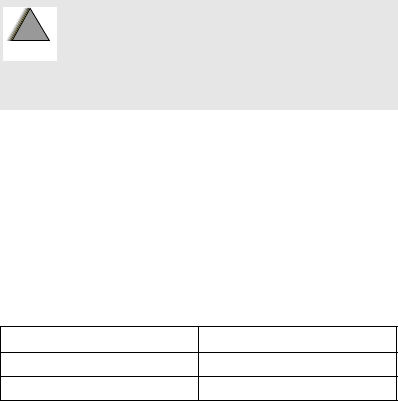
5
INSTALLATION AND PROGRAMMING
With the option board installed, your portable
Professional Series Radio is enabled with Bluetooth
technology. See your local Motorola representative for
installation and programming.
Note to installer:
Refer to the portable Professional Series Radio service
manual for option board installation procedures. In
addition, you must replace the radio’s existing retainer
with a modified version (as indicated below) for proper
Bluetooth antenna operation. The modified retainers
and associated pads are included with the option board.
If your current retainer has pads attached, duplicate the
pad layout of your current retainer on your modified
retainer using the enclosed pads.
A separate identification label is also enclosed. Please
apply this to the back of the radio, under the battery.
If installed in any FM Professional Series
Radio, FM Approval of that radio is negated.
If installed in any mobile Professional
Series Radio, the option board will be
damaged. For portable use only.
Replace Current Retainer With Modified Retainer
42D80498Z01 01D85596E01
42D86266Z01 01D85596E02
!
W A R N I N G
!
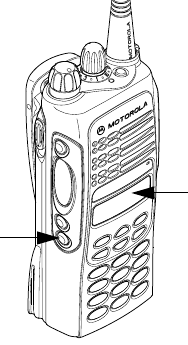
6
BLUETOOTH RADIO OVERVIEW
Portable Radio: Button and Symbol Locations
(Display Model shown)
Your Bluetooth radio will connect and operate with a
Bluetooth two-way radio audio device from Motorola. A
Push-To-Talk device with Bluetooth Wireless
Technology from Motorola can also be used along with
the Bluetooth audio device. Bluetooth audio and Push-
To-Talk devices are sold separately.
N
Option board
symbol indicates
option board is
installed and
activated.
Side Button 3
(SB3)
7
Connecting for the First Time
1. Turn Bluetooth radio on.
Double SCAN tone sounds every two seconds.
Note: To stop scan, press SB3 twice (short presses).
You should press SB3 only briefly before releasing it; do
not hold down SB3.
2. Turn Bluetooth device(s) on.
3. Place Bluetooth device(s) within 3 in. (7 cm.) of the
front of the radio. This must be done within a few
seconds of turning on the radio.
Connection occurs with first Bluetooth device.
CONNECT tone sounds and tracking number
appears on display radio model.
Note: Each Bluetooth device has a unique 10-digit
tracking number (e.g., DA0FBL0000) for device
identification.
If you are not connecting to a second device, short-
press SB3 twice.
If you are connecting to a second device, keep all
devices within 3 in. (7 cm.) of each other until
CONNECT tone sounds again. Tracking number
appears on display radio models.
4. Operate devices.
You can now move devices outside the 3-in. (7-cm.)
connection range once connected.
Note: If connection occurs with only a Bluetooth Push-
To-Talk device, the connection will be dropped because
this device will not operate by itself.
8
Note: If connection does not occur, restart connection
(start at Step 2 in “Connecting to Different Device(s)” on
page 11) and make sure you are on an option board–
enabled channel (see “Channel Change” on page 10).
Verifying Connection
You can verify the connection between the Bluetooth
radio and Bluetooth device after a connection is made.
1. Short-press SB3 on radio.
2. Within two seconds of SB3 press, press and hold
PTT button on Bluetooth device.
You are connected if:
• VERIFY tone sounds on the radio.
• Tracking number appears on display.
3. Release PTT on Bluetooth device to exit verification.
Note: If this does not occur, try again, making sure to
short-press SB3 on radio first, before pressing PTT on
Bluetooth device, and making sure to press PTT within
two seconds of SB3 press. If there is still no VERIFY
tone or tracking number, the radio is not connected with
the Bluetooth device. See “Connecting to Different
Device(s)” on page 11 to restart connection.
Receiving a Call
When a call is received, you hear receive audio on
Bluetooth audio device.
Note: Use volume control on Bluetooth device to adjust
volume. You cannot adjust with Volume/On/Off knob on
Bluetooth radio.
9
Sending a Call
To activate microphone on Bluetooth audio device,
press PTT button on Bluetooth audio device or PTT
button on Bluetooth Push-To-Talk device.
Pressing the radio’s PTT button activates only the
microphone on the radio.
Note: Before transmitting, monitor frequency via your
radio.
Resolving a Lost Link
Note: ALWAYS KEEP YOUR TWO-WAY RADIO
READILY AVAILABLE FOR USE IN THE EVENT THE
CONNECTION IS LOST.
When connection is lost:
• ALERT tone sounds on radio once for each lost
device.
• Tracking number of each lost device appears on
display radio models.
•Bluetooth radio automatically tries to reconnect for
30 seconds.
• CONNECT tone sounds once for each device
reconnected.
If you think you have moved out of range, move devices
closer together to restore lost link.
You will be able to send and receive calls from your
radio until connection is established again. See
“Guidelines on Interference and Lost Links” on page 1.
10
Channel Change
The option board can be enabled or disabled per
channel. See your local Motorola representative for
programming information.
If the option board is enabled on every channel, there is
no interruption in Bluetooth connection when channel is
changed.
If the option board is disabled on some channels and
you switch to a disabled channel, you will hear a
CHANNEL CHANGED ALERT tone one second after
switching. Bluetooth devices become inoperable,
though still connected. Switch back to enabled channel
within three seconds to prevent dropped connection.
Ending a Connection
If you do not want to operate with Bluetooth device(s),
you need to end the current connection:
• Short-press SB3 twice.
You hear one ALERT tone for each Bluetooth device
disconnected.
Note: You can also turn radio off for a few seconds, then
back on. This disconnects and turns off Bluetooth
device(s).
Connecting to Last Device(s)
You can quickly reconnect to the last device(s) that
linked to your Bluetooth radio.
1. Turn Bluetooth radio on.
11
Single SCAN tone sounds every two seconds.
Note: To stop scan, short-press SB3 twice, and then
short-press SB3 twice again.
2. Turn Bluetooth device(s) on.
3. Place Bluetooth device(s) within 3 ft. (1 m.) of the
front of the radio. This must be done within a few
seconds of turning on the radio.
Connection occurs with Bluetooth audio device.
CONNECT tone sounds and tracking number
appears on display radio model.
If you were not previously connected to a Bluetooth
Push-To-Talk device, go to Step 4.
If you were previously connected to a Bluetooth
Push-To-Talk device, connection occurs. CONNECT
tone sounds again and tracking number appears on
display radio model.
4. Operate devices.
Note: If reconnection does not occur, turn radio off and
return to Step 1. If you are attempting to connect to a
different device, start at Step 2 in “Connecting to
Different Device(s)”, below.
Connecting to Different Device(s)
You can connect your Bluetooth radio to a different
Bluetooth device(s).
1. If you are in a connection, short-press SB3 twice to
disconnect. If not in a connection, go to Step 2.
ALERT tone sounds for each device disconnected.
12
2. Short-press SB3 twice to begin to scan for device(s).
Double SCAN tone sounds every two seconds.
Note: To stop scan, short-press SB3 twice.
3. Turn Bluetooth device(s) on.
4. Place Bluetooth device(s) within 3 in. (7 cm.) of the
front of the radio. This must be done within a few
seconds of pressing SB3 twice.
Connection occurs with first Bluetooth device.
CONNECT tone sounds and tracking number
appears on display radio model.
If you are not connecting to a second device, short-
press SB3 twice to stop scan.
If you are connecting to a second device, keep all
devices within 3 in. (7 cm.) of each other until
CONNECT tone sounds again. Tracking number
appears on display radio models.
5. Operate devices.
You can now move devices outside the 3-in. (7-cm.)
connection range once connected.
Note: If connection occurs with only a Bluetooth Push-
To-Talk device, the connection will be dropped because
this device will not operate by itself.
Note: If connection does not occur, restart connection
(start at Step 2, above).
Turning Radio Off
Turn the radio’s Volume/On/Off knob until it clicks.
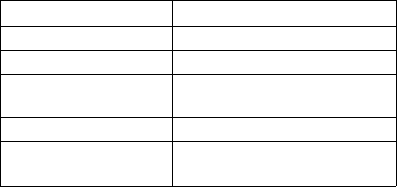
13
Note: Any Bluetooth-connected device(s) is powered
down.
Tone Description
Troubleshooting
If at any time you cannot reestablish the Bluetooth
connection or a device is operating incorrectly, turn the
radio and Bluetooth device(s) off and try to reconnect.
Service
The RLN5381 option board with Bluetooth Wireless
Technology is not serviceable. Order replacement kit as
necessary.
Warranty
The RLN5381 option board with Bluetooth Wireless
Technology is covered under the standard Motorola one
(1) year limited warranty. See your local Motorola
representative for more information.
Tone Description
CONNECT Three rapid high tones
ALERT Single half-second low tone
CHANNEL CHANGED
ALERT
Continuous low tone
VERIFY Continuous high tone
SCAN Single or double low tone
repeated every two seconds
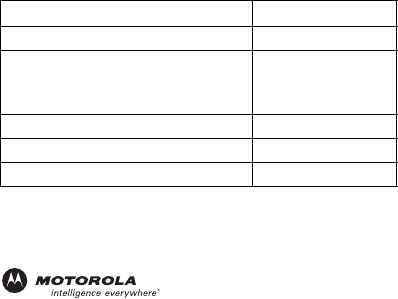
Replacement Parts
Motorola, Inc.
8000 West Sunrise Boulevard
Ft. Lauderdale, FL 33322
MOTOROLA and the Stylized M Logo are registered in the U.S. Patent and
Trademark Office.
BLUETOOTH is a trademark owned by their proprietor and used by
Motorola, Inc., under license.
© Motorola, Inc. 2002
All Rights Reserved. Printed in the U.S.A.
*6880309L69-O*
6880309L69-O
Part Motorola Part No.
Retainer/pad kit RLN5389
Modified retainer replacement for:
42D80498Z01
42D86266Z01
01D85596E01
01D85596E02
Small rectangular pad 7586000Z01
Larger rectangular pad 7580671Z01
V-shaped pad 7585943Z01